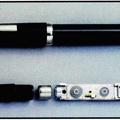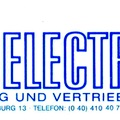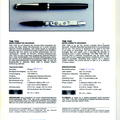

|
 人,各自不同,觀點歧異。 人,各自不同,觀點歧異。
咱喜歡的,孩子未必在意。 那天一口氣沒接上,什麼都帶不走。 說都沒得說,什麼珍藏全都進了垃圾筒。 只好現下做點功夫,留在網路上。 那怕將來都化成灰燼,還留下一點蛛絲馬跡。 瞻仰也好,朝聖也好,總是曾經走過的蹤跡。 《念奴嬌》 赤壁懷古 蘇軾 大江東去,浪淘盡,千古風流人物。 故壘西邊,人道是,三國周郎赤壁。 亂石崩雲,驚濤裂岸,捲起千堆雪。 江山如畫,一時多少豪傑。 遙想公瑾當年,小喬初嫁了,雄姿英發,羽扇綸巾,談笑間,強虜灰飛煙滅。 故國神遊,多情應笑我,早生華髪。 人生如夢,一樽還酹江月。 |

|
文章數:18 |
 瞎蛙棲舍的意外收藏:補充德國Protona特殊小型隱藏式錄音機介紹(Minfon Miniature wire recorder) 瞎蛙棲舍的意外收藏:補充德國Protona特殊小型隱藏式錄音機介紹(Minfon Miniature wire recorder) |
| 興趣嗜好|收藏 2018/12/10 01:55:32 |
瞎蛙棲舍的意外收藏:補充德國Protona特殊小型隱藏式錄音機介紹(Minfon Miniature wire recorder)
相關影片:
PROTONA MINIFON P55 WIRE RECORDER DEMO(https://youtu.be/jG42zgkvZ1k)
相關報導:
For Your Eyes Only: the Secret Microphone Wristwatch Worn by Cold War Spies-March 10, 2017 Words By Blake Z. Rong(https://wornandwound.com/eyes-secret-microphone-wristwatch-worn-cold-war-spies/
Minifon在1951年面市,產品主訴是小尺寸便攜(small portable size),並聲稱可以放置在使用者的襯衫口袋裡!不過,以歐美人士的身材,再假設每個人都已經準備一件超大尺碼(ginormous)的襯衫的話。 然而,相較於當年歐美地區流行的Websters和silvertone家用錄音機而言,它的確算得上是小尺寸的便攜機種。 以最暢銷的P55機種為例,外觀尺寸約為7*4*1.6吋(換算成公制單位大約是17.8*10*4cm)。 電池需求:依照瞎蛙棲舍粗淺的電學知識,這款1951年面市的Minifon P55「隱藏式鋼絲錄音機」內部是以真空管為音頻放大的設計,所以它的供電系統是由3電池供電,包括: 一個1.5V,AA尺寸的「絲級電池」(filament battery)用以射出電子 一個30伏的電池做為屏極電壓-陽極金屬接收板收集電子 另外需要一個12V電池提供錄音鋼絲的捲軸馬達動力。 在回播時則可以用交流電源供應器提供上述直流壓。 燈絲電池可以20至30小時的電力供應,陽極電池則有150至200小時的壽命,至於馬達電池則只能提供10至12小時的電力。 Minifon P55配備的麥克風其實是先進麥克風與揚聲器(即喇叭)合一的設計。當然也可以選擇單一功能的麥克風、揚聲器及耳機。 Minifon P55最早在美國上市的時間大約是在1950年代初期,當時售價289美元,以當年的科技水平而論,確實是最精巧的設計(microminiaturization)。尤其是P55採用電池供電的微三級真空管技術(3 micro vacuum tubes)設計,不需要沉重的變壓及整流電路,成為許多國家首選的間諜錄音機。 Minifon還替Minifon P55設計了偽裝成手錶的麥克風。 資料來源:Minifon p55 wire recorder collections Posted 20120302 Ebay auction
Victor Jr Joined: Fri Mar 02, 2012 4:11 pm Posts: 2 Im selling my world class Minifon collection. The original spy recorder. It includes 8 minifon recorders.( 1 p-55 kit, 2 attache, 1 p55 L, 3 p55 S, and 1 Protana ITT Special. 3 microphone wristwatches, 5 speakers , original boxes, 3 ac power supply, 1 automobile connecting cord, carry cases, 1 telephone adapter, manuals, 2 original batteries, plus recording wire. Im not sure what does and does not work. Below is some info from websites. Minifon P55 (1951) Somewhat out of the time sequence, but will be listed here to keep all wire recorders grouped together... The Minifon was released in 1951. Its main attribute was its small portable size and claimed to fit in ones shirt pocket (assuming I suppose. one has a Gi-normous shirt pocket !.... ) Nevertheless, compared to the Websters and Silvertone home machines etc, it was indeed truly portable. The P55 (the most popular) measured approx 7x4x1.6". It was powered by 3 batteries: a single 1.5 v filament battery (AA size), a single 30 V anode battery (plate voltage supply) and a single 12V battery for the reel/capstan motor drive. An optional AC adapter was available that only supplied 9-12v for the motor drive, which was the battery with the shortest life and also (naturally) the most expensive. The filament battery had a life expectancy of 20 to 30 hrs, the anode battery: 150 to 200 hrs, and the motor battery: 10 to 12 hrs. The included microphone served as both a microphone as well as a speaker - - though an optional telephone pickup, headphone, as well as a dedicated "full" sized speaker was available at additional cost. The P55 initially sold for $289 here in the US back in the early 1950s (quite a hefty sum back then), but it was truly portable and considered state of the art "microminiaturization" for its day. The P55 employed vacuum tube technology with 3 "micro" (and considered highly power efficient) vacuum tubes. Since it was battery powered, a rectifier tube and thus power supply was not required, as all operating voltages were supplied from the 3 on board batteries (that alone saved a lot of weight and significantly reduced the number of required components) Not surprisingly, it was quickly adopted by many governments as being the ultimate "spy" recorder of its day. Minifon even designed a wristwatch microphone, that looked like a watch, but was actually a microphone ! Today, that wristwatch microphone is somewhat of a collectors item. Fidelity was on par with the full size Websters, despite the wire size being nearly half the thickness of the much larger Webster reels (which was already hair thin). Due to the extremely thin wire used, wire breaks are far more of a problem. Minifon also opted for non-standard spool sizes and recording speed, insuring that only their equipment could be used for playback. Standard Webster style reels recorded at an industry agreed on 24 ips, while Minifon used a proprietary 30 cm/sec or about 11.8 ips.
|
| 最新創作 |
|
||||
|
||||
|
||||
|
||||
|
||||
| 精選創作 |
|
||||
|
||||
|
||||
|
||||
|
||||
| 最新影像 | 20 本 259 張 |
|
|
|
|||||||||








